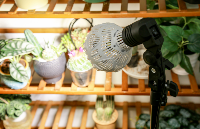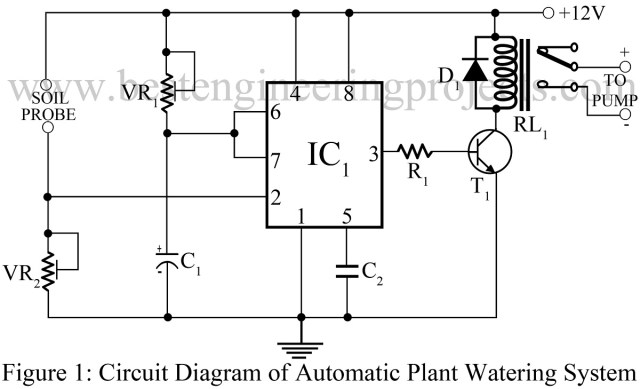關鍵字:缺水告警電路

R1___________470K1/4W Resistor
R2_____________3K3 1/4W Resistor
R3___________100K 1/2W Trimmer Cermet
C1_____________1nF 63V Polyester Capacitor
C2____________47μF 25V Electrolytic Capacitor
D1__________1N4148 75V 150mA Diode
D2_____________5mm. Red LED
IC1___________4093 Quad 2 input Schmitt NAND Gate IC
P1,P2_______Probes (See text)
SW1___________SPST Slider Switch
B1______________3V Battery (2 AA 1.5V Cells in series)
Device purpose:
This circuit is intended to signal when a plant is needing water. A LED illuminates at maximum brightness when the ground in the flower-pot is too dry: it dims gradually as the water's content in the pot grows, turning off when the optimum moisture's level is reached. This condition is obtained trimming R3.
Circuit operation:
IC1D forms a square wave oscillator with approx. 10/90 mark-space ratio. It feeds the output probe P1 and its signal, inverted by IC1A is compared with that picked-up by P2 in the NAND gates IC1B & IC1C in parallel, driving the LED. When a low resistance exists between the probes, due to an high water's content in the flower-pot, the LED is off, turning gradually on as the resistance between the probes increases.
Notes:
- A square wave is used to avoid probes' oxidization.
- Probes can be long nails, carbon rods obtained from disassembled exhausted 1.5V batteries, or even a couple of screwdrivers.
- The probes must be driven in the pot's ground a few inches apart.
- Due to 3V supply, the LED needs not a limiting resistor.
- Power consumption: LED off = 50μA; LED full on = 1mA.
- To switch-off the circuit, you can short the probes. In this case SW1 can be omitted.
- Using an high-efficiency LED, brightness variations are better emphasized. In this case a limiting resistor could be necessary.
發布評論請先 登錄
相關推薦
養護新科技!三思照明全光譜支架植物燈更“懂植物”

dac3171 config5的alarm_dataclk_ gone有告警是什么原因?
DAC3484只要對寄存器進行寫操作都會觸發alarm,在此期間txenable保持為0,沒有數據傳輸怎么解決?
請問ADS8661寄存器如何配置可使alarm輸出報警?
電極式傳感器不告警的原因有哪些
LITESTAR 4D應用:溫室植物照明案例
請問如何定位SMU中alarm的報警源?
藍牙連接失敗,打印alarm_set failed to start timer, err 0x103如何解決?
“鐵衛”級防水防腐:LP20系列連接器解決植物生長燈連接難點

分享一個簡單的自動植物澆水系統電路





 植物缺水告警器,water alarm for plant
植物缺水告警器,water alarm for plant












評論